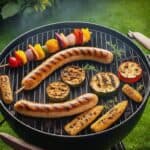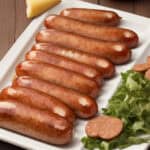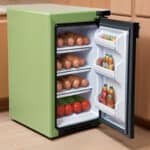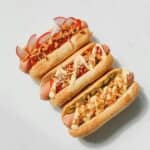According to Chef Achatz, “Grilling is one of life’s great pleasures.” Mastering grill fundamentals like indirect heat takes time but promises success.
Learning techniques for sausages and other foods ensures thorough cooking without burning.
Controlling temperature safely with tested methods means great taste and quality time with family. Master the basics through practice for rewarding results each cookout.
Key Takeaways
Grilling involves using direct or indirect heat to cook foods over a heat source. Whether gas or charcoal, the basics of proper heating, food preparation and safety will ensure perfectly grilled results.
How to Grill Chicken Sausage
As the warm weather hits, my family loves enjoying meals outdoors on our gas or charcoal grill. We find chicken sausage is a healthy and tasty option for summer grilling.
I will share our simple process for cooking chicken sausage using indirect heat on the grill for moist, flavorful results.
PREPARE YOUR CHICKEN SAUSAGE
Getting your ingredients in order is the first step for any successful grilling. I start by removing the sausages from their packaging and patting them dry with towels.
Having damp sausage won’t allow you to get a good sear or cook them through properly. Once dry, I like to generously season them all over with favorite flavors like salt, pepper, and garlic powder to boost the grilled meat’s taste.
- Remove sausages from packaging and discard any wrappers
- PAT sausage dry with paper towels. Damp sausage will not cook as well.
- SEASON sausage all over with salt, pepper, garlic powder, or your favorite GRILLING spices.
PREPARE YOUR GRILL
Whether you use a gas or charcoal grill, it’s important to set it up to allow for indirect cooking. For gas grills, I light the burners on only one side to create direct and indirect heat zones. With charcoal grills, I bunch the coals to one side. This helps cook the sausage through gently without flareups or burning.
- Use a GAS or CHARCOAL grill and prepare for INDIRECT HEAT cooking
- For gas, light only one side of the burners
- For charcoal briquets, bank them to one side of the grill
- Get the grill HOT. Temperature should be around 350°F.
| Grill Type | How to Set Up for Indirect Cooking |
|---|---|
| Gas | Light only one side of burners |
| Charcoal | Bank coals to one side |
Getting the grill hot, around 350°F, is key so the sausage doesn’t take forever to finish cooking (1).
COOK THE SAUSAGES
Now it’s time to get cooking! I carefully place the seasoned sausages on the cooler side of the grill rack, away from the direct heat. With the lid closed, I let them cook for 15-20 minutes, flipping occasionally, until reaching 165°F internally.
- Place sausages on the cooler, unlit side of the grill away from direct heat
- Close lid and cook for 15-20 minutes, flipping occasionally, until sausages reach an internal temperature of 165°F
- Use a meat thermometer inserted into the thickest part of the sausage to check temperature
- WATCH carefully during the last 5 minutes of cooking as sausage can easily burn
Keeping a close eye during the last few minutes prevents overcooking. The sausage is done when it reaches a safe internal temperature and develops some nice browning.
ENJOY!
Once the sausage is finished grilling, I love to snack on it straight off the grill or serve it on buns with all the classic fixings. Some of my favorites to accompany the sausage are grilled grill grates, hot dogs, or other cuts of meat.
Most importantly, be sure to follow basic food safety practices throughout the cooking and serving. With this simple method utilizing indirect heat, you’ll be enjoying flavorful chicken sausage all summer long!
Credit : Tasty
Tips for Perfectly Grilled Chicken Sausages
GRILLING RECIPES centered around CHICKEN BREASTS are at the top of my menu planning. One option I regularly turn to are mild chicken sausages, which grill up juicy and flavorful with just a few simple tips.
PREP YOUR GAS GRILL
For best results, I like to use my trusty GAS GRILL. Before cooking, be sure to CLEAN YOUR GRILL grates thoroughly to prevent sticking. Light the grill and allow it to preheat on HIGH HEAT. Once hot, adjust to an INDIRECT GRILLING setup by liting only one side of burners.
PREPARE THE SAUSAGES
Getting ingredients ready sets the stage. I start by removing sausages from their packaging and patting dry…
- Remove sausages from packaging and pat dry with paper towels
- Brush or rub entire links with oil or melted butter to support browning
- Season generously with salt, pepper, garlic, herbs – whatever SMOKY FLAVOR profile you prefer
Properly preparing the sausages with a light coating of oil or butter and seasonings of choice ensures good browning and infusion of smoky flavor.
GRILL TO PERFECTION
Once the grill is preheated and set for indirect cooking, arrange sausages away from direct heat. Cook covered for 15-20 minutes, flipping links occasionally, until casings are lightly charred and internal temp reaches 165°F.
| Grilling Tips | Details |
|---|---|
| indirect heat | Cooks sausage gently and prevents burning |
| vent grill lid | Allows moisture to escape for crispy skin |
| watch closely | Don’t overcook – sausage can dry out! |
SERVE AND ENJOY!
Perfectly grilled chicken sausage is delicious on buns, over GRILLED CORN or as part of a veggie-packed kebab with other GRILLED VEGETABLES. With these simple tips, you’ll be making restaurant-quality sausage all summer long!
Common Mistakes to Avoid
Learning from mistakes is the best way to perfect your grilling technique. I’ll discuss some common errors and how to prevent them for delicious results every time.
SETTING UP YOUR BURNER GAS GRILL
One mistake is not preheating your grill properly before cooking. Allow your BURNER GAS grill to reach the needed COOKING TEMPERATURE to prevent food from sticking or cooking unevenly.
UNDERSTANDING HEAT ZONES
It’s important to recognize the HOT SIDE versus COOLER SIDE of your grill (2). Placing foods directly over the flames on the hot side often results in charring or burning. Take advantage of the cool zone by moving foods there if needed.
GRILLING WITH DRY HEAT
Grilling in a DRY HEAT environment allows for desirable browning. Mistakes like placing overly sauced foods or closing the lid too frequently disrupt this and cause steams. Leave the lid open when possible for best color.
CLEANING UP SAFELY
Always let your grill cool fully before attempting to clean INSIDE THE GRILL to avoid burns. Safety should come before convenience when doing any grilling.
- Allow ashes to cool in the bottom before emptying
- Never leave a lit BURNER GAS GRILL unattended
- Be on alert for ZONE FIRES which can occur near grease drippings
With awareness and care, you can prevent common gaffes that lead to spoiled food or worse, FOODBORNE ILLNESS. Practice grill skills and safety to enjoy this cooking method for seasons to come.
FAQ
How do I know when the bottom of the grill is hot enough for cooking?
The bottom of the grill should be hot enough for cooking when you can hold your hand about 4 inches above the grate for less than 3 seconds.
You want the bottom of the grill to reach high temperatures of 500°F to 600°F for charcoal grilling or medium-high to high heat for a propane gas grill.
Test the heat by sprinkling a few drops of room temperature water over the grate; it should sizzle and evaporate within a few seconds.
What kinds of starters can I use for charcoal grilling?
There are a few different options for starters when charcoal grilling. A chimney starter is one of the most popular and effective starters. Simply crumple newspaper in the bottom and add charcoal briquettes and/or lump charcoal.
Light the paper at the bottom and it will light the charcoal above. An electric starter uses a heating element to light the charcoal.
You can also use paraffin starters, which are solid blocks of flammable wax that light easily and allow you to light multiple areas of charcoal at once. Liquid fire starters are poured directly onto the charcoal and lit with a match.
How close should I be able to outdoor grill to the house?
For safety purposes, your outdoor grill should be at least 10 feet away from any outdoor overhead combustibles and at least 25 feet from any windows or doors that could lead into your home.
Set up the grill on a flat, stable, and non-combustible surface, such as concrete, keeping in mind the clearances to structures. Avoid grilling under carports or patio covers. Outdoor grilling should only be done outdoors away from any structures for safety.
How long do I need to cook grilled shrimp?
When grilling shrimp, the cooking times can range depending on the size of the shrimp but typically only take a few minutes. For shrimp that are large, jumbo or colossal size, figure 2 to 3 minutes per side will be sufficient to cook them through.
For medium or small shrimp, roughly 1 to 2 minutes per side should do the trick. The shrimp are done when they are pink or opaque all the way through. Check for doneness by cutting into one to check that it’s no longer translucent.
How do I slow cook food on my charcoal grill?
To slow cook on a charcoal grill, you’ll use the indirect heat grilling technique. Pile all the lit charcoal briquettes to one side of the grill, leaving the other side empty.
Place a disposable aluminum foil pan on the empty side and add a small amount of water or other liquids to create humidity. Put the food, such as brisket, pork shoulder, or chicken on the indirect, empty side, away from the heat source.
Use a heat source like hardwood chunks on the charcoal to produce smoke. Close the lid and cook low and slow at temperatures between 225°F to 300°F, adding new charcoal as needed, until the food is very tender and reaches the proper doneness.
Spritzing the meat with apple juice or other sauces during the cook time adds extra moisture and flavor. Check on it every hour or so and enjoy!
How do I cut meat for grilling?
When preparing cuts of meat like steaks, chicken breasts or pork chops for grilling, there are a few tips for proper cutting. First, make sure the meat is at room temperature before grilling. This allows it to cook more evenly.
Then, trim off any excess fat, as this can cause flare ups on the hot grill. Cut the meat against the grain into even portions or slices about 1/2 inch to 1 inch thick for quick and even grilling. Cuts like boneless chicken breasts can be pounded thinner for faster cooking.
Cuts like steak or pork tenderloin can be left thicker for medium-rare doneness. Cutting the meat into uniformly sized pieces ensures consistent cooking times.
What is the difference between direct and indirect heat grilling?
There are two main types of heat setups when grilling: direct and indirect (3). Direct heat grilling involves placing the food directly over the hottest part of the grill, usually over the flames or hot coals. This is best for quicker cook times and getting nice grill marks.
Indirect heat grilling places the heat source to one side of the grill and the food on the other side, away from the direct heat. The lid is kept down and the food cooks more slowly and gently in the wafting heat.
Indirect grilling works well for thicker cuts of meats that need a longer cook time at a lower temperature, like pork shoulder or brisket. Knowing how to set up direct vs indirect heat allows you to choose the best method for different types of food.
What should I keep in mind when grilling meat and vegetables directly on the cooking surface?
When grilling meat and vegetables directly on the grates, there are some best practices. Use a stainless steel wire grill brush to clean the hot grates before use.
Lightly oil the cooking surface so foods don’t stick. Cut larger foods into similarly sized pieces for even cooking. Place foods toward the edge of the grill racks rather than directly over the flames/coals for gentle cooking.
Use tongs or a spatula instead of a fork, which punctures foods. Cook foods just until they have nice grill marks on one side before flipping once, keeping an eye on timing to avoid burning. Resist the urge to flatten or compress foods while grilling.
Flip pieces over only once for best grill marks. Watch for doneness and remove pieces promptly once they reach the desired internal temp.
Conclusion
I hope these grilling tips have fired you up to get cookin’! Whether you prefer gas or charcoal, indirect or direct heat, with some practice of the basics, you’re sure to start churning out restaurant-quality meals for friends and family to enjoy. While grilling may seem intimidating, don’t be afraid to try new recipes and techniques.
Remember – practice makes perfect, so don’t be afraid to make mistakes. That’s how all us grill masters learn. Mostly have fun with it! There’s nothing better than cooking with good company on a warm summer night.
Feel free to experiment and don’t be afraid to get those taste buds tantalized. Happy grilling! Let me know if you have any other grilling questions! Leave a comment below.
References
- https://www.bbqqueens.com/what-temp-to-grill-sausage/
- https://www.seriouseats.com/the-serious-eats-guide-to-grilling
- https://www.tasteofhome.com/article/direct-vs-indirect-heat/
Related Articles
- https://milkwoodrestaurant.com/what-is-a-smoke-tube/
- https://milkwoodrestaurant.com/best-way-to-reheat-grilled-chicken/
- https://milkwoodrestaurant.com/how-to-use-grill-pan-in-oven/
Was this helpful?
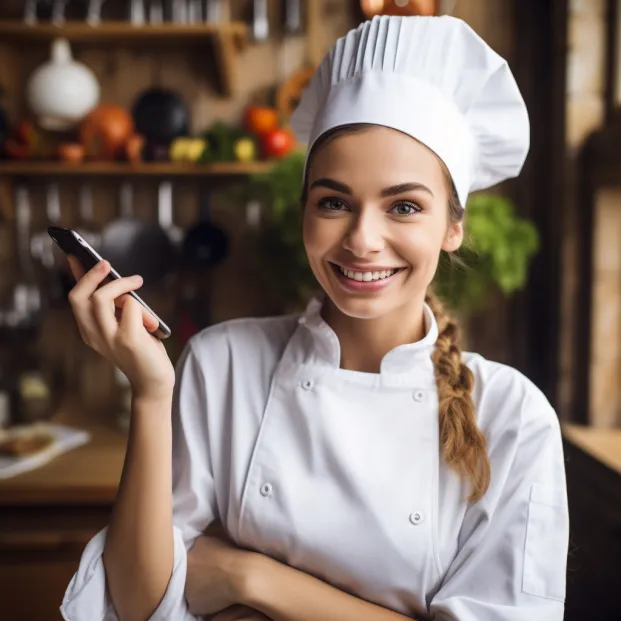
I’m Mary R. Q. , a seasoned professional chef dedicated to elevating home cooking experiences. Through my expertise in the culinary arts, I provide practical cooking tips and insightful reviews of kitchen utensils on my blog, milkwoodrestaurant.com. As a passionate advocate for transforming everyday meals into extraordinary culinary adventures, I aim to empower home cooks with the knowledge and tools they need to create delicious and memorable dishes. I’m also an author of the book “1,001 Kitchen Tips & Tricks: Helpful Hints for Cooking, Baking, and Cleaning (1,001 Tips & Tricks)” which is sold on Amazon. Join me on a flavorful journey as we explore the art of cooking and the essential tools that make it a joy.

